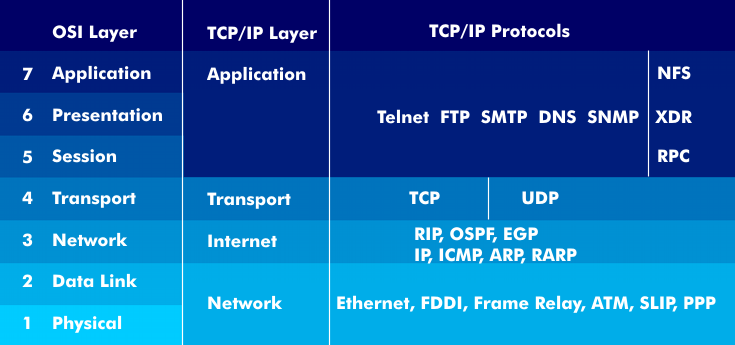transmission control protocol/internet protocol (TCP/IP)
The TCP/ IP protocols were developed as early as the 1970s by the Research Project Agency( DARPA) of the US Department of Defense( DoD) with the support of the National Bureau of Standards( NBS). The goal was to create protocols that were as code-compact as possible for the Interface Message Processor( IMP) of the Arpanet.
After that, nobody was interested in TCP/IP for a long time, because it was hoped to be able to realize interconnection in heterogeneous networks on the basis of OSI protocols. This hope was deceived and the protocols, which had meanwhile been further developed in the Unix sector, quickly became popular for networking a wide variety of systems. Because of the comparatively small implementation and space expenditure they were also gladly used for personal computers( PC).
Today, no professional system can be found that cannot be equipped with TCP/IP protocols. Thus, the DoD protocol family is the only way of communication in many mixed environments today. The relatively low effort has of course its price: in this case in the variety of functions and in the performance e.g. for file transfer.
The development of the TCP protocols
The development of the TCP protocols was significantly influenced by the experiences in the DARPA Internet (formerly ARPAnet), as well as by specifications and so-called Requests For Comments( RFC).
The TCP/IP protocol stack consists of the Network Interface Layer( NIL), which is responsible for the transmission of data packets on the medium and their reception, the overlying Internet Layer, which is responsible for addressing, packetization and routing functions, and the overlying Transport Layer, which supports the Application Layer in their session and communication services. The core protocol of the Internet Layer is the Internet Protocol (IP), others are the Address Resolution Protocol( ARP), the Internet Control Message Protocol( ICMP) and the Internet Group Management Protocol ( IGMP), and for routing, the Open Shortest Path First ( OSPF ) protocol and the Routing Information Protocol( RIP). The core protocols of the transport layer are the connection-oriented TCP protocol and the connectionless User Datagram Protocol( UDP).
All of the protocols from the TCP/IP environment directly support the functionality of the network layer and the transport layer, as well as various applications that are built on top of the TCP/IP protocols. Applications include Telnet, the File Transfer Protocol( FTP), Simple Mail Transfer Protocol( SMTP), r commands, X-Window, Simple Network Management Protocol( SNMP), and various others.

